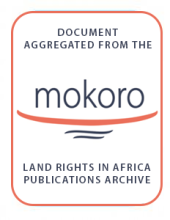Land Library Search
Through our robust search engine, you can search for any item of the over 73,000 highly curated resources in the Land Library.
If you would like to find an overview of what is possible, feel free to peruse the Search Guide.
/ library resources
Showing items 46 through 54 of 108.The Agriculture Strategic Development Plan is a national policy with a multi-sectoral approach. The Timeframe of this Plan is 3 years between 2010 and 2012.
ABSTRACTED FROM INTRODUCTION: Lao PDR is the least densely populated country in Asia and has long been remote and isolated from the rest of the continent. This role has only recently begun to change.
Since early 1990’s Tanzania has implemented far reaching macroeconomic and structural reforms which has led to substantial socio-economic development. GDP growth per annum has almost doubled over the last decade from 4.1% in 1998 to 7.4% in 2008, with an average growth of 7% per annum.
Agricultural sectors play a key role in the economics of climate change. Land as an input to agricultural production is one of the most important links between economy and the biosphere, representing a direct projection of human action on the natural environment.
En el marco de la Quinta Reunión Ministerial “Agricultura y Vida Rural en las Américas” y en el contexto del Proceso Cumbres de las Américas llevado a cabo en Montego Bay, Jamaica, del 26 al 29 de octubre de 2009 se firmó el PLAN AGRO 2003-2015, Acuerdo Ministerial Hemisférico Jamaica 2009 para l
The Association of Southeast Asian Nations (ASEAN) has been trying hard to go into free trade agreements (FTAs) with different countries. It believes that this will increase trade and help members sell their export products to more markets in other countries.
Sustainable land management requires that water and matter (nutrients and base cations) are efficiently recycled within ecosystems so that irreversible losses of matter from topsoils are minimised. Matter losses are connected to water flow.
For many millions in the developing world, land is central to livelihoods, food security, even identity – the result of a direct dependence on agriculture and natural resources.








